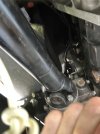Hi, I would much appreciate your thoughts on diagnosing the source cause of a clunk sound I get about 1 second after I shift into every manual gear (both high and Low mode). I appears there is play somewhere in the drivetrain. When I jack up the passenger side of the front axle, I have to turn the wheel 2 1/2 inches before the drivetrain engages and starts turning the front prop shaft. It also clunks when I apply and release the gas peddle. I paid $270 to have a shop diagnose it (they specialize in Land Rovers). After only 10 minutes, the technician estimated it was the transmission until I showed them a video of the front axle side of the propeller shaft making a clunk when I popped the clutch. You would think the clunk was coming from the the U-Joint, but the mystery is that it did not move a bit. A week later I produced and showed a video to the manager and he suggested just replacing whole prop shaft which didn’t make sense to me because the only part on the shaft that could cause that sound would be the u-joint and it is clear from the video that there was no u-joint movement. The clunk can be heard from both the front axle and transfer case sides of the prop shaft. Unfortunately, I am unable to get the video to load on this site because it has a .mov extension. However, I have attached a shot of the showing the transfer case side of the prop shaft.
Play in drivetrain evidenced by clunk
- Thread starter rklemm
- Start date
This site contains affiliate links for which LandyZone may be compensated if you make a purchase.

